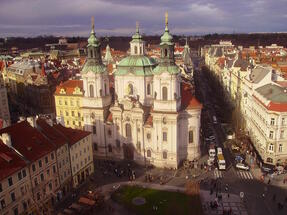In the beginning was Hermès
After the fall of communism, a significant market opened up for Western brands in the countries of the Eastern Bloc. Thanks to its convenient location and high tourist attractiveness, the Czech Republic became the first country where luxury brands decided to expand. The first brand that had a representative in Prague was Versace in 1995. However, Hermès opened the first luxury boutique in Pařížská Street itself in 1997, followed by Louis Vuitton a year later. Today in Prague's Pařížská street you can visit a total of 26 boutiques dedicated to fashion and accessories, 7 jewelry, 6 luxury watches, 4 leather accessories and 2 luxury shoes. One store belongs to Nespresso, the only representative on the street in the food and beverage category.
“After the arrival of Hermés, it took less than 10 years for the street to become a luxury shopping destination with a mix of direct and partner stores. Over the past decade, the high street has only strengthened with the arrival of better brands and the replacement of multi-brand stores with direct brands. There is one more multi-brand store left at Pařížská 17, which caters to brands such as Tom Ford, McQueen, Loewe, Givenchy, Balmain, Chloe, Jacquemus and Off-White, which will most likely also soon show interest in getting their own brand store. Fortunately for us and for the brands, Pařížská Street is also expanding. The reconstruction of the Fairmont Hotel includes several new commercial spaces along Pařížská Street," comments Marjan Gigov from Colliers.
Cartier, Fendi, Hermès and Dior: The most popular brands of Czechs
According to the available data, Cartier was the only brand that saw an increase in turnover of around 2.4% in 2020, when borders were closed and retailers had to rely only on local customers. Fendi came in second, followed by Hermès and Dior. These data indicate that these four brands are among the most popular among Czech customers. On the contrary, the largest decrease in turnover in the same period was recorded by the Gucci brand (approx. 64% decrease), followed by the Louis Vuitton and Prada brands (approx. 46% decrease), which points to the dependence of these brands on tourists.
"After the end of the pandemic in 2022, approximately 6 million tourists visited the Czech Republic, which represents a decrease of 26% compared to the time before covid-19. Nevertheless, several brands managed to achieve exceptionally good results in terms of turnover. Dior, for example, was able to exceed its turnover from 2019 by 73% this year, while Hermès achieved a 41% increase in turnover," adds Marjan Gigov, adding that it was this positive trend that caused interest in Prague's Prime High Street to grow on the part of other brands as well.
Who else in CEE will reach Prime Hight Street?
"At Colliers, we are trying to make other capital cities of Central and Eastern European countries attractive destinations for luxury brands. As can be seen on Prague's Pařížská street, the creation of Prime High Street is a long way to go, but since it represents a symbol of prestige that attracts attention and admiration from all over the world, the effort is definitely worth it," explains Marjan Gigov, adding that among other adepts include Budapest and Warsaw. Budapest is relatively close to creating a Prime High Street, it's a beautiful city, the number of tourists is increasing every year and Andrassy Boulevard already has several luxury brands such as Louis Vuitton, Jimmy Choo, Moncler and Gucci, plus room for more here still is. However, the weak economy and the lower purchasing power of the local population prevent the creation of an environment desirable for luxury brands. Warsaw is one step closer to Prime High Street. Many luxury brands even have a presence here, albeit only thanks to partner multi-brand stores. However, it is a relatively quick journey from them to your own branded boutique, especially when the situation is affected by the increasingly strong purchasing power of local residents and the growing number of tourists.


